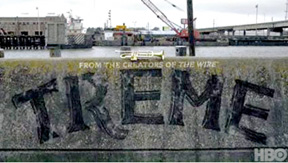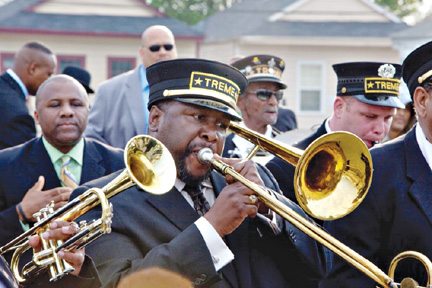Review: Television Worth Watching
David Simon Re-Opens the Floodgates
The New Orleans drama Treme shows its Baltimore roots

by Diana Beechener
Baltimore writer extraordinaire David Simon has a natural sense of rhythm. You could feel it in his Baltimore opus The Wire: each way of life, be its followers police or drug slingers, had its own distinct rhythm. So when Simon decided to leave Charm City for The Big Easy, the transition didn’t miss a beat.
HBO and Simon’s new show Treme (premiered April 11; Sundays at 10pm) chronicles the rebuilding of post-Katrina New Orleans three months after the levees failed, when citizens began returning home.
Like The Wire, the first episode of Treme isn’t so much about story as it is teaching the audience the rhythms of the city. Street musicians like Wendell Pierce’s (Bunk on The Wire) Antoine Batiste — serve as the smooth rhythm section, swinging back into step hustling cab drivers and playing small gigs. College professor Creighton Bernette (John Goodman) is the percussion section, shouting staccato indictments of the government to every news outlet he encounters.

Mardi Gras Indian Tribe leader Albert Lambreaux (Clarke Peters; another Wire alumnus) is the soulful baseline trudging as he rebuilds his fractured life. Lawyer Toni Bernette (Melissa Leo; Homicide, Life in the Street) is the horn section, blowing through red tape trying to make corrupt police answer for their crimes.
Plot threads are present, but they come second to the music and the people of New Orleans. Simon’s intricate plotting rewards only viewers who pay attention to his composition.
The only sour note so far has been Steve Zahn’s Davis McAlary, a tiresome DJ whose role seems to serve as reminder that annoying people live in New Orleans, too.
This show is about pain, but so is most of the jazz that inundates Treme. The show’s website offers you a play list with each episode. But like jazz, Treme finds joy in catharsis, in a sense of mutual suffering and rebirth. The first question on everyone’s lips is How’s your house? But they don’t let the bad-news bring them down. Simon portrays the people as wounded but not felled.
The first episode begins with a parade and ends with a funeral, and Simon outlines the similarities of the two events. Both feature sharp horn work by Batiste, both bring the community to the streets and both signify that a change has come.
Though Treme focuses on a topic that has inundated media, documentaries and television shows, Simon doesn’t start off with the big picture. He’s busy writing the notes, each carefully crafted character and precisely chosen jazz track. He’s focused on the rhythm; the symphony will come.
|
![]()



